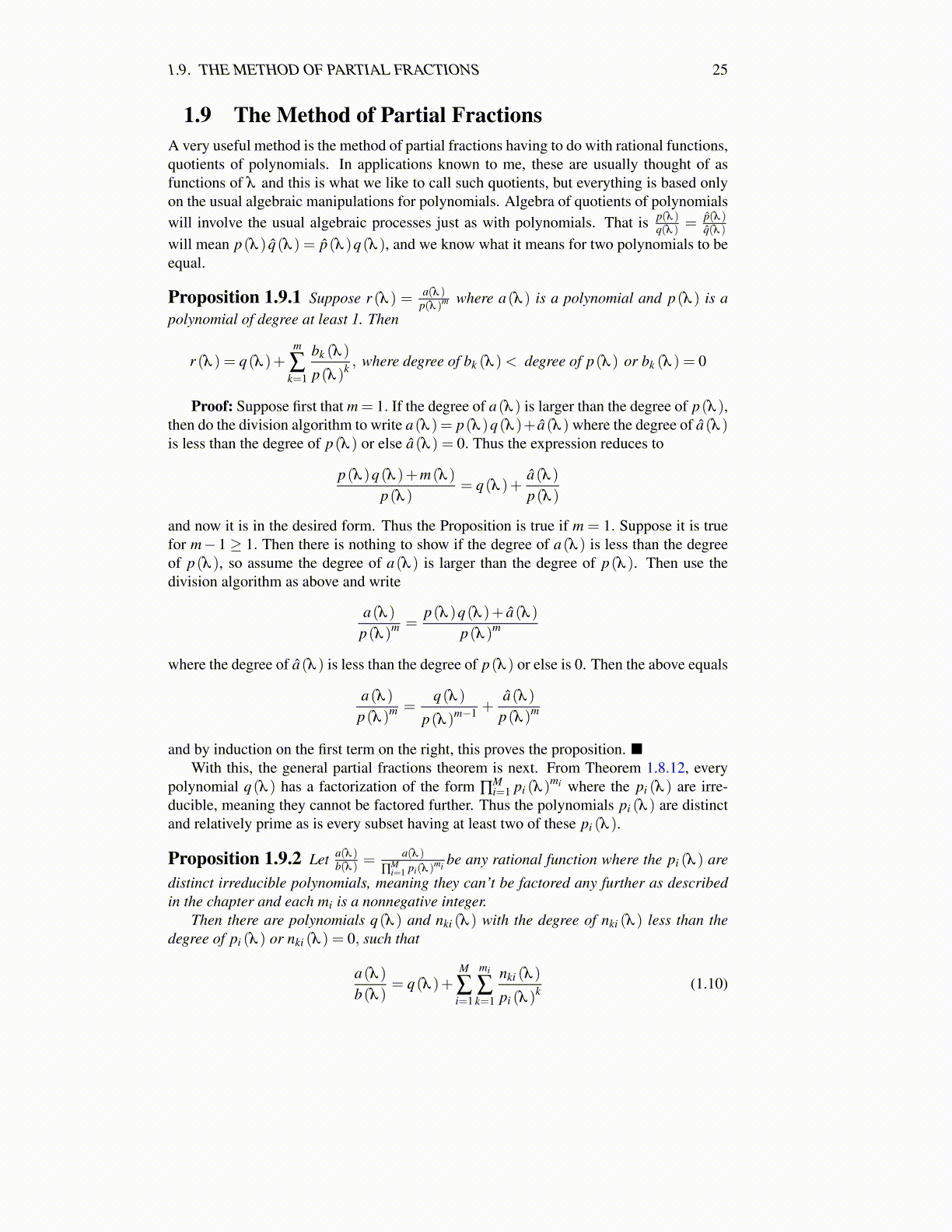
1.9. THE METHOD OF PARTIAL FRACTIONS 25
1.9 The Method of Partial FractionsA very useful method is the method of partial fractions having to do with rational functions,quotients of polynomials. In applications known to me, these are usually thought of asfunctions of λ and this is what we like to call such quotients, but everything is based onlyon the usual algebraic manipulations for polynomials. Algebra of quotients of polynomialswill involve the usual algebraic processes just as with polynomials. That is p(λ )
q(λ ) =p̂(λ )q̂(λ )
will mean p(λ ) q̂(λ ) = p̂(λ )q(λ ), and we know what it means for two polynomials to beequal.
Proposition 1.9.1 Suppose r (λ ) = a(λ )p(λ )m where a(λ ) is a polynomial and p(λ ) is a
polynomial of degree at least 1. Then
r (λ ) = q(λ )+m
∑k=1
bk (λ )
p(λ )k , where degree of bk (λ )< degree of p(λ ) or bk (λ ) = 0
Proof: Suppose first that m = 1. If the degree of a(λ ) is larger than the degree of p(λ ),then do the division algorithm to write a(λ ) = p(λ )q(λ )+ â(λ ) where the degree of â(λ )is less than the degree of p(λ ) or else â(λ ) = 0. Thus the expression reduces to
p(λ )q(λ )+m(λ )
p(λ )= q(λ )+
â(λ )p(λ )
and now it is in the desired form. Thus the Proposition is true if m = 1. Suppose it is truefor m− 1 ≥ 1. Then there is nothing to show if the degree of a(λ ) is less than the degreeof p(λ ), so assume the degree of a(λ ) is larger than the degree of p(λ ). Then use thedivision algorithm as above and write
a(λ )p(λ )m =
p(λ )q(λ )+ â(λ )p(λ )m
where the degree of â(λ ) is less than the degree of p(λ ) or else is 0. Then the above equals
a(λ )p(λ )m =
q(λ )
p(λ )m−1 +â(λ )
p(λ )m
and by induction on the first term on the right, this proves the proposition. ■With this, the general partial fractions theorem is next. From Theorem 1.8.12, every
polynomial q(λ ) has a factorization of the form ∏Mi=1 pi (λ )
mi where the pi (λ ) are irre-ducible, meaning they cannot be factored further. Thus the polynomials pi (λ ) are distinctand relatively prime as is every subset having at least two of these pi (λ ).
Proposition 1.9.2 Let a(λ )b(λ ) =
a(λ )∏
Mi=1 pi(λ )
mi be any rational function where the pi (λ ) are
distinct irreducible polynomials, meaning they can’t be factored any further as describedin the chapter and each mi is a nonnegative integer.
Then there are polynomials q(λ ) and nki (λ ) with the degree of nki (λ ) less than thedegree of pi (λ ) or nki (λ ) = 0, such that
a(λ )b(λ )
= q(λ )+M
∑i=1
mi
∑k=1
nki (λ )
pi (λ )k (1.10)